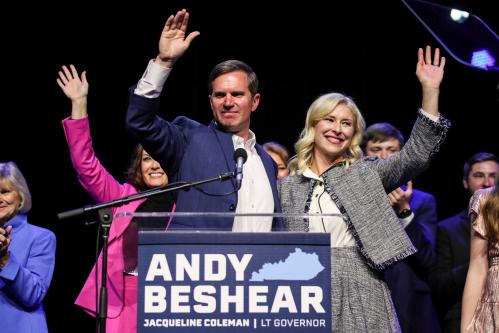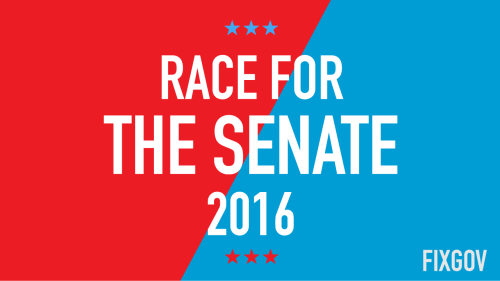This post is part of the series Race for the Senate 2018.
 Montana’s Jon Tester is one of five “red state” Democratic U.S. Senators trying to keep his head above the rising tide of electoral vulnerability in a state where Trump won big just two years ago. The consensus among most election prognosticators earlier this summer was that Tester appeared to have a relatively comfortable lead over Republican challenger, Matt Rosendale, but the race appears to have tightened considerably since. And, as we enter the final three weeks of the campaign, many observers now consider the contest a toss-up.
Montana’s Jon Tester is one of five “red state” Democratic U.S. Senators trying to keep his head above the rising tide of electoral vulnerability in a state where Trump won big just two years ago. The consensus among most election prognosticators earlier this summer was that Tester appeared to have a relatively comfortable lead over Republican challenger, Matt Rosendale, but the race appears to have tightened considerably since. And, as we enter the final three weeks of the campaign, many observers now consider the contest a toss-up.
The race holds major implications both for control of the U.S. Senate and party politics back in Montana. In the Senate, Democrats’ narrow chances of capturing the chamber leave little margin for error, and a Tester loss would likely signal doom. In Montana, where recent developments have left the Democrats’ candidate pool near completely empty, a Rosendale victory would usher in a total GOP domination of Montana’s Senate delegation that would likely stretch beyond the foreseeable future.
Three major issues in the campaign
As the election has heated up over the summer and into fall, three prominent issues have emerged: healthcare, corruption, and public lands access. First, like many other races across the country, healthcare has been a focal point. Rosendale, the challenger, has taken advantage of Tester’s incumbent status to pin responsibility for rising insurance rates on him and others back in Washington. Tester has dismissed these allegations while countering that, as Montana’s current insurance commissioner, Rosendale had real ability to prevent insurance rates from increasing but did nothing. Independent analysis suggests neither side has it totally right.
Also related to Rosendale’s brief tenure as insurance commissioner is a second major issue: corruption. While late to evolve during the campaign cycle, allegations of corruption from both sides have become a central issue in recent weeks. The latest allegation against Rosendale suggests that he used his authority as state auditor to dismiss an existing case against owners of a Billings-based company who had donated $10,000 to help alleviate Rosendale’s debt from a failed 2014 run for Montana’s lone U.S. House of Representatives seat. Other issues regarding campaign finance have plagued Rosendale throughout the campaign, such as when audio emerged that some see as evidence that he coordinated directly with the National Rifle Association regarding political advertising content. Tester, meanwhile, has been roundly criticized by Rosendale and his allies for being the top recipient of lobbyist cash in the U.S. Senate.
Public lands are a third major issue in the campaign. Access to public lands has been a central theme in Montana political campaigns for many years and is seen as a crosscutting issue of import to Democrats, Republicans, and independents alike. Because both candidates portray themselves as staunch advocates for public lands access, differentiation on this issue has largely boiled down to credibility. On this score, Tester alleges that Rosendale’s recent change of heart on whether public lands management should be transferred from the federal government to the states (a policy deeply unpopular in Montana and one that Rosendale advocated for during his run for the U.S. House in 2014) is nothing more than a temporary political stunt to help his electoral prospects. Rosendale, meanwhile, charges Tester with not having done enough to improve public lands access and management during his tenure in the U.S. Senate.
Trump-approved vs. Montana roots
Perhaps even more important than the issues listed above, however, is the ongoing rhetorical battle being waged between the two candidates regarding what this election is really about.
Republicans have invested greatly in conveying the election as a referendum on the president. Even as Republican candidates in many other parts of the country have tried to distance themselves from Trump, whose favorability is notably low across the country as a whole, Rosendale’s pledged fealty to the president makes sense in Montana, where the president bested Clinton by 20 points and his favorability numbers remain above 50 percent.
President Trump has also visited Montana on three occasions to stump for Rosendale (in July, September, and October), holding rallies in three of the state’s largest cities. Vice President Mike Pence and Donald Trump, Jr. have also visited the state multiple times on Rosendale’s behalf. Some see the fact that Tester’s advantage over Rosendale has slowly dwindled over the summer as evidence that these campaign stops have improved Rosendale’s prospects. At times, the Tester campaign has felt compelled to respond to the Trump narrative and have typically chosen to highlight the fact that Trump has signed over 20 of Tester’s bills into law.
While Rosendale has tried to make the race as Trump-centered as possible, Tester has taken a decidedly different tack, emphasizing his multi-generation connection to rural Montana and, by extension, Montanans themselves. Tester’s campaign leverages his background as a seven-fingered, third generation rural Montana dirt farmer in order to convey an authenticity rooted in Montana the place in hopes of signaling to voters that he is “one of us.”
As important, Tester and his allies have invested millions to ensure that Montanans are aware of the contrast between him and his opponent, whom Tester refers to as “Maryland Matt,” the “fake rancher” who’s “all hat and no cattle.” On this score, Rosendale counters that beneath Tester’s folksy veneer is a man who’s “gone Washington,” having sold out to “the swamp” and coastal liberal elites.
While Tester is particularly well-suited for the role, this is not a new strategy among Montana Democrats. Current Democratic Montana Governor (and native) Steve Bullock recently employed the same strategy to defeat his GOP opponent, dubbed “New Jersey Greg,” on the very same day that Trump cruised to victory by 20 points.
Connection to place looms large in some way for both candidates. For Tester, an authentic connection rooted in the soil of his third-generation family farm is his key to overcoming his chief weakness in Montana: the national brand of his own party. For Rosendale, meanwhile, connection to Montana—or his lack thereof—is his chief weakness. To overcome it, Rosendale must make Trump and his connection to the people the dominant issue in voters’ minds when they cast their ballots, thus making the battle to control the election narrative—place vs. Trump—of utmost importance.









Commentary
Race for the Senate 2018: Key issues in Montana
October 26, 2018